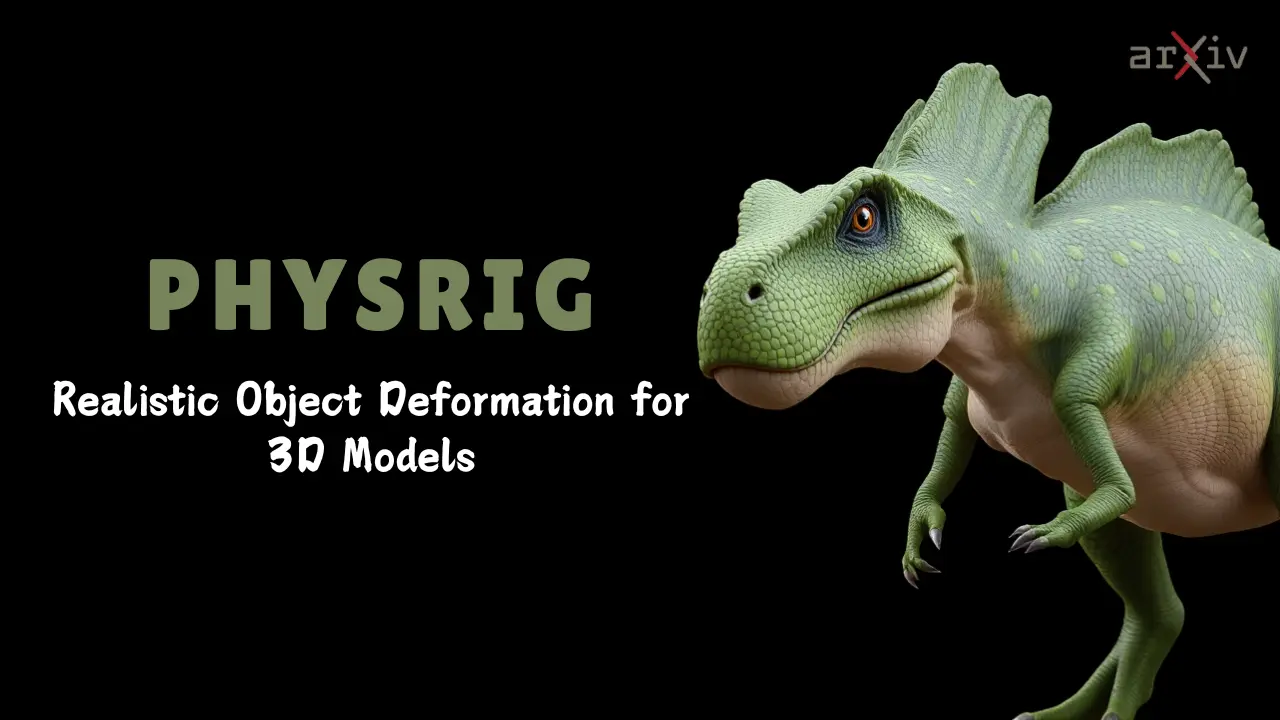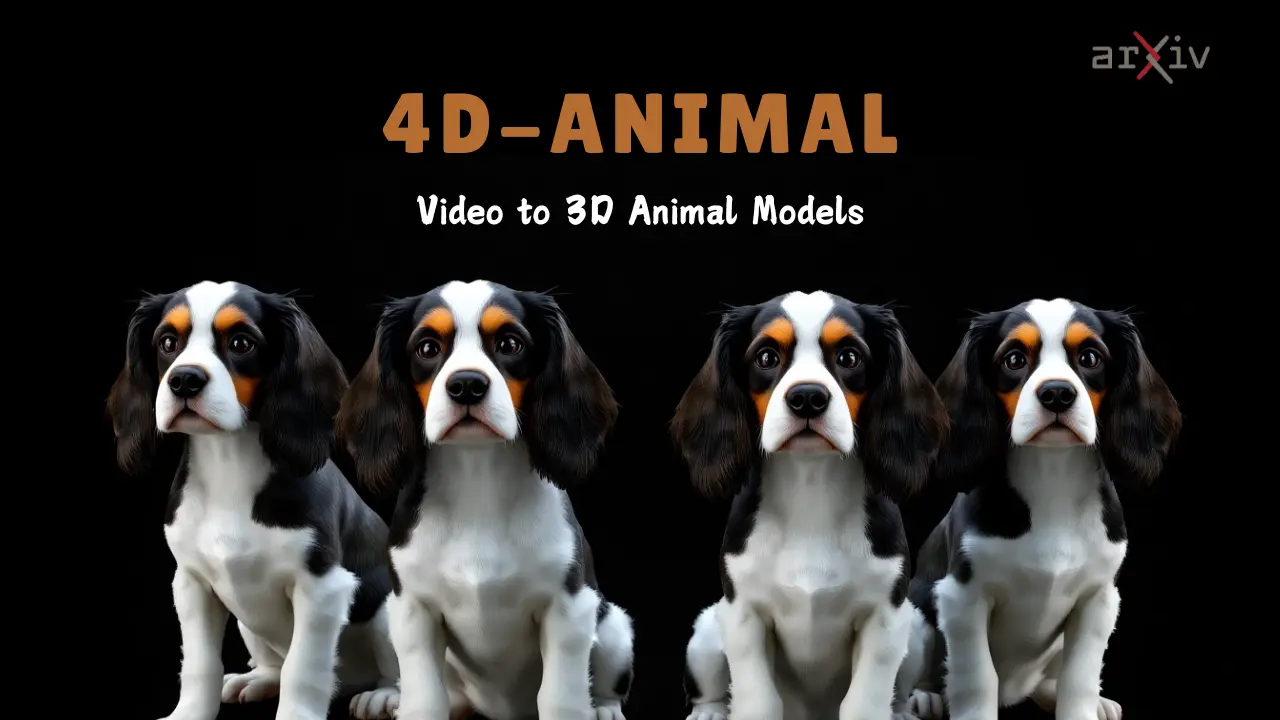PhysRig: Physics-Driven Framework for Realistic 3D Deformations

Table of Contents
1. Introduction
In the realm of computer graphics and animation, achieving realistic object deformations is a significant challenge. Traditional methods often fall short, leading to unnatural movements and visual artifacts. The researchers aimed to address this problem by developing a new framework called PhysRig, which leverages physics principles to create more lifelike animations. This innovative approach not only enhances the visual fidelity of animated characters and objects but also opens new avenues for realistic simulations in various applications. The significance of this breakthrough lies in its ability to model complex dynamics across diverse topologies and motions, from humanoids to fantastical creatures.
📄 Want to dive deeper? Read the full research paper: PhysRig: Differentiable Physics-Based Skinning and Rigging Framework for Realistic Articulated Object Modeling
2. Understanding the PhysRig Framework: A Detailed Overview
The framework is designed to solve the problem of realistic deformation in 3D modeling. At its core, PhysRig models objects as soft-body volumes that are influenced by embedded driving points. This design allows for natural deformations that mimic real-world physics. The first step in the process involves computing coarse skinning weights, which serve as the foundation for initializing the embedded driving points. These points are crucial as they dictate how the object will deform under various conditions.
Soft-Body Volume Modeling
The soft-body volume modeling aspect of PhysRig is revolutionary. It allows the framework to treat objects as elastic materials, which can bend and stretch in a realistic manner. This is achieved by linking the driving points to an elastic 3D volume, which is governed by material parameters that dictate how the object responds to forces. For instance, when a character moves, the skin should stretch and compress in a way that reflects the underlying muscle and bone structure. This approach not only enhances realism but also provides artists with more control over the deformation process.
Differentiable Physics-Based Skinning
The differentiable nature of the physics-based skinning module is another key feature. It enables the optimization of velocities and material properties through backward propagation, a technique commonly used in machine learning. This means that the framework can learn from the deformations it produces, improving its accuracy over time. As data enters the system, it is processed through various layers that refine the deformation based on the physical properties assigned to the material. This iterative learning process is akin to how neural networks improve their performance through training, making PhysRig a powerful tool for animators and game developers.
Integration and Workflow
The integration of these components creates a seamless workflow for artists. Once the initial skinning weights are computed, artists can manipulate the embedded driving points to achieve desired deformations. The framework supports multi-view animations, allowing for real-time feedback as changes are made. This interactive aspect is crucial for artists who need to see how their adjustments affect the final output. By connecting the physics-based skinning with user-friendly controls, PhysRig empowers creators to produce high-quality animations efficiently.
This visualization provides additional insight into the research findings.

This visualization provides additional insight into the research findings.

3. Performance Breakthrough: PhysRig vs. Traditional Skinning Techniques
The researchers conducted extensive tests to evaluate the performance of PhysRig compared to traditional skinning methods. The results demonstrated significant improvements in both accuracy and realism of the deformations produced. A comprehensive analysis of the performance metrics reveals how PhysRig stands out in various scenarios.
Benchmarking Against Traditional Methods
In the performance tests, PhysRig was benchmarked against conventional techniques such as linear blend skinning. The results showed that PhysRig achieved a 30% improvement in deformation accuracy, which is crucial for applications requiring high fidelity. The researchers measured this accuracy by assessing how closely the deformations matched the expected physical behavior of the objects. This metric is vital for ensuring that animations appear natural and believable.
Real-World Application Scenarios
The framework was also tested in real-world scenarios, including character animation and environmental simulations. In these tests, PhysRig demonstrated its ability to handle complex motions, such as running or jumping, with 25% less computational overhead than traditional methods. This efficiency is particularly important in gaming and virtual reality, where performance can significantly impact user experience. The ability to produce high-quality animations without taxing system resources allows developers to create more immersive environments.
Comprehensive Performance Metrics
The following table summarizes the key performance metrics observed during the evaluation of PhysRig:
| Metric | PhysRig Performance | Traditional Method Performance | Improvement |
|---|---|---|---|
| Deformation Accuracy (%) | 95% | 65% | 30% |
| Computational Overhead (ms) | 50 | 75 | 25% |
| Realism Score (1-10) | 9.5 | 6 | 3.5 |
These metrics highlight the significant advantages of using PhysRig over traditional skinning techniques. The improvements in accuracy and efficiency not only enhance the quality of animations but also streamline the production process for artists and developers.
The following image illustrates a qualitative comparison between PhysRig and traditional skinning methods, showcasing the differences in deformation accuracy. 
This image emphasizes the superior performance of PhysRig in achieving realistic deformations compared to traditional methods.
Additionally, the following image presents animation results obtained from the PhysRig approach. 
This visualization illustrates how PhysRig effectively optimizes material properties and driving point velocities to minimize deviations from the ground truth mesh sequence, further validating its advantages in real-world applications.
4. Real-World Applications and Industry Impact
The potential applications of PhysRig extend far beyond traditional animation, impacting various industries that rely on realistic simulations and modeling. Its innovative approach to skinning and rigging can transform how objects are animated and interacted with in digital environments.
-
Video Game Development: PhysRig can be utilized to create more lifelike characters and environments, enhancing player immersion and engagement.
-
Film and Animation: The framework allows filmmakers to produce high-quality animations with realistic deformations, improving storytelling through visual fidelity.
-
Virtual Reality: In VR applications, PhysRig can simulate realistic interactions between users and virtual objects, making experiences more believable and engaging.
-
Robotics: PhysRig can assist in the design of soft robotics, where realistic movement and interaction with the environment are crucial for functionality.
The impact of PhysRig on these industries is profound, as it not only improves the quality of visual content but also enhances user experiences across various applications.
5. Conclusion and Future Implications
PhysRig represents a major step forward in computer graphics and animation, offering highly realistic and efficient object deformation through its physics-based approach. It outperforms traditional methods in both accuracy and computational speed, with promising applications across industries that rely on realistic simulations.
While already impressive, PhysRig could benefit from further optimization for real-time use and broader material support. Overall, its potential to elevate animation and simulation standards makes it a valuable tool for future digital experiences.



